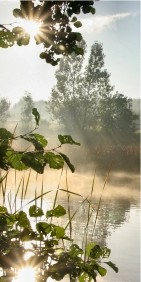 Principe
All green plants need sunlight for their reproduction, the energy from sunlight acts upon a green pigment (chlorophyll) which combines with water and carbon dioxide from the local environment to produce sugars and oxygen. Chlorophyll absorbs sunlight in two main areas of the spectrum; comprising red light (centred about 650nm) and blue light (around 425nm) (leaves look green as blue and yellow are main colours reflected by chlorophyll).
The red end of the spectrum is used by chlorophyll to fix carbon dioxide and water in sugars, with a by-product of oxygen. Blue light (425nm) is used, inter alia, as an energy source to drive internal membrane transport processes, essentially to provide the raw materials to the right places so that they can be made into sugars, and that waste products are excreted.
Blue dye absorbs an amount of red light and thus reduces the efficiency of photosynthesis; however, it does not restrict respiration, which is largely independent of light, thereby making plants and algae exhaust themselves without the ability to absorb more carbon dioxide to fix into sugars which are used as the main energy source for the plant cell. Without the drive of red light these functions cannot proceed as there is no energetic input to maintain the reaction.
  Photosynthesis
Photosynthesis is the manufacturing of sugars from carbon dioxide and water, in the presence of chlorophyll and light energy. Oxygen is then released as waste from the process.
The light source used for photosynthesis is natural daylight. It is this element of photosynthesis that can be manipulated to stunt the growth of algae and submerged weeds.
In a pond containing clear water, light easily passes through and any plants or nutrients present use this to grow. Plants get taller and grow towards the surface and single cell organisms (such as algae) start to float towards the surface. It is the floating, or suspended cells that can make the pond water take on the "pea green soup" look.
By preventing some of the light from reaching below the surface of a pond, photosynthesis is interrupted in deep-lying pond life such as algae. However, surface life such as lily pads or reeds, which photosynthesis either on or above the surface of the water, will not be affected. As it is not practical or desirable to have ponds built indoors or permanently covered, it has become necessary to develop another way of preventing the light from reaching the base of the pond
 Works in all gardens, ponds and lakes
- Very economical to use
- Simple application methods
- Saves time and effort
- Blocks light, denying algae's food source.
- Lasts up to three months
- Free of pesticides and herbicides
- Harmless to plants, fish, filters and wildlife
- All year round use  Who uses's DyoFix algae inhibitors
- Local councils
- Golf clubs
- Stately homes
- Private gardens
- Commercial fisheries |
